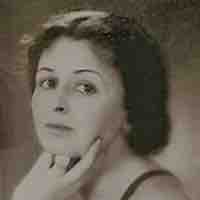Ernestine Drucker Freud
1896-1980

Ernestine (Esti) Freud was born in Vienna in 1896. She married Martin Freud, the son of Sigmund Freud, in 1919. Esti Freud became a speech therapist in Vienna, working with Emil Froeschels and Heinrich Neumann at what was to become the famous Neumann Clinic—a training center for speech pathologists from all over the world.
She described her experience training with Froeschels as follows:
She paid a steep fee for the course. The course was taught at the Ambulatorium, a clinic that was part of the Ear, Nose and Throat department led by Dr. Heinrich Neumann. She describes her training as follows:
The training was rigorous. Every morning I had to be at the clinic at 9 and work until noon. Selected readings were assigned for the afternoon. Dr. Froeschels had a contract with the public school system. Children with speech, language, voice and hearing impairments were instructed in special classes. Every day a teacher whose specialty was communication disorders, brought his or her class to the clinic for a consultation with Dr. Froeschels. The students sat in a semicircle by the side of the professor who taught by discussing the different cases.
At the beginning of my training, case histories were dictated to me. Following the school children, cases were referred from different departments of the hospital were seen and the means of therapy were explained. Three times a week there were formal lectures on subjects involving a great variety of speech disorders such as aphasia, cleft palate, stuttering, voice loss, and consequences of hearing impairments, etc. …
Froeschel’s favorite lecture theme was philosophy, and he used this lecture to attack Freud’s concept of the unconscious. The attacks on Freud detracted from Froeschel’s reputation as a philosopher. He should never have deviated from his field of specialization (Freud, 1979, p. 39-42).
In 1938 Esti Freud emigrated to France and separated from her husband. After the German invasion of France she fled to Morocco and later, in 1941, to the USA, where she completed her Ph.D in clinical psychology at the New School for Social Research. She graduated 1955, at the age of 59.
During the period of 1941 to 1971, she worked as a speech pathologist, in different places in the New York area. Her specialty was voice.
Esti Freud’s New York Times Obituary, November 2, 1980
Dr Esti Freud, daughter-in-law of Sigmund Freud, died on Wednesday, October 29 at the age of 84. She worked as a speech pathologist from 1941-1971 at Cornell Medical College, New York Hospital and at the East Orange Veterans administration Hospital. She published numerous papers on speech and voice pathology. Dr. Freud was a member of the International Logopedic Association, the American Speech Association, the NY Psychological Association, and the NY Women’s Medical Association. She is survived by one daughter and one son, six grandchildren and one great grandchild.
Writings of Esti Freud, arranged chronologically
Freud, E. (1945). Contribution to treatment of chronic laryngitis in persons who use their voice professionally. Practa Oto-rhino-laryngologica. 7, 483-488.
Freud, E. (1948). Speech therapy: Experiences with patients who had undergone total laryngectomy. Archives of Otolaryngology, 48, 150-155.
Freud, E. (1950). Speech rehabilitation of patients with cleft palate. Archives of Otolaryngology. 51, 685-695.
Freud, E. (1951). Speech rehabilitation in a case of organic aphasia. Case Reports in clinical Psychology, 2, 23-25.
Freud, E. (1951). Clinical language rehabilitation of the veteran: Methods and results. American Journal of Psychiatry, 107, 12, 881-889.
Freud, E.(1953). Recent trends in aphasic research. American Journal of Psychiatry, 110, 3, 186-193.
Freud, E. (1953). Recent trends in aphasic research . In: American Journal of Psychiatry, 110, 86-193
Freud, E. (1955) The social implications of language disturbances . Ph. D. New School for Social Research, 1955
Freud, E. (1955). Voice physiology and the emergence of new vocal styles. Archives of Otolaryngology, 62, 50-58.
Freud, E. (1956). Speech and voice training of the deaf. Archives of Otolaryngology, 5, 63, 183-195.
Freud, E. (1957). What causes stuttering? Acta Psychiatria & Neurologica Scandanavia, 32, 1, 137-150.
Freud, E. (1958). Voice and breathing. A report on some new concepts. Archives of Otolaryngology, 67, 1-7.
Freud, E. (1958). The enunciation of the sound ‘r’. Logopaedia en Phonitrie, 30, 1-8.
Freud, E. (1959). The otolaryngologist and the symptom of hyper-rhinolalia. Arch. Otolaryng, 70, 32-41.
Freud, E. (1961). Some problems of function and dysfunction of the ventricular folds. Logopedie en Foniatrie. 33/10, 1-12.
Freud, E. (1962). Functions and dysfunctions of the ventricular folds. Journal of Speech and Hearing Disorders, 27, 4, 334-340.
Freud, E. (1963). Common vocal disturbances and suggestions for therapy. Logopedie en Foniatrie, 35, 5, 61-70.
Freud, E. (1966). Sex differences in speech and hearing performances. Logopedie en Foniatrie.
Freud, E. D. (1979). Vignettes of my life (1899-1979). Leo Baeck Center for Jewish History, Digital Collections.
Writings about Esti Freud and the Freud Family
Freud, S. ( 2007). Living in the shadow of the Freud family. Praeger. (Written by Sophie Freud, daughter of Esti.)
Friedman, L. (1956) Other Freud Centenary Celebrations. Journal of the American Psychoanalytic Association, 4, 595-601.
Lixl-Purcell, A. (1988). Women in exile. Greenwood Press. Esti Freud’s chapter: Beyond My Understanding.
Yorke, C. (1997). Review of Paul Roazen’s Meeting Freud's Family. Psychoanalytic Psychology, 14:555-564.
